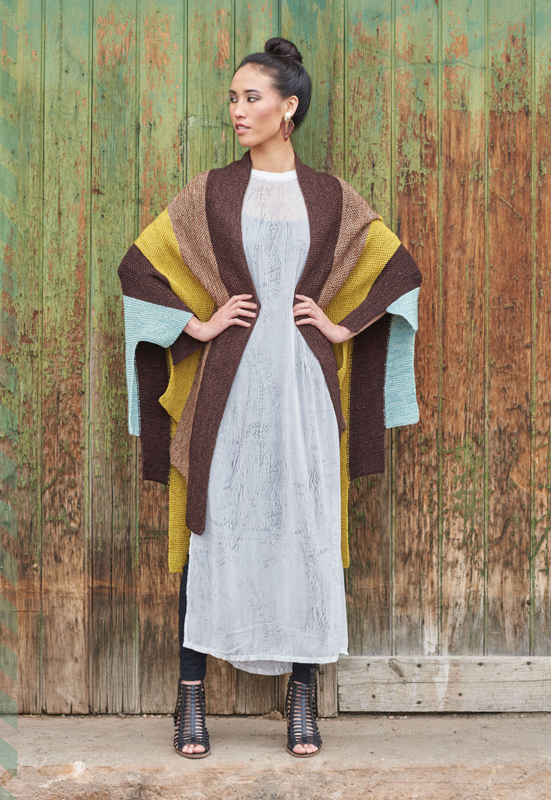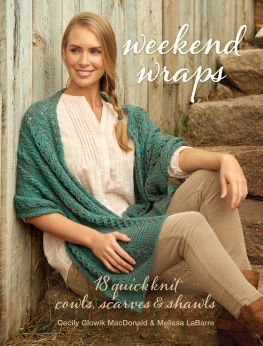Contents
Guide

CITY-INSPIRED KNITTING PATTERNS FOR THE MODERN WARDROBE
by Kyle Kunnecke

TABLE OF CONTENTS
INTRODUCTION
A Home in the City
CHAPTER ONE
Planning the Trip: Advice for the City Knitter
CHAPTER TWO
Sightseeing: Sweaters for the Journey
CHAPTER THREE
A Change in Seasons: Wraps & Scarves
CHAPTER FOUR
Souvenir Shopping: Accessories


INTRODUCTION
A Home in the City
Childhood trips along the winding country roads of southern Indiana were like a journey into a different world. As we headed south across the Ohio River, the skyline of Louisville, Kentucky, swallowed us whole. I spent every moment attempting to take it all in. Even at a young age I remember thinking, Every building I see was built by hand, one bit at a time.
My dad would take me to work (he was a construction superintendent) on occasion. Id stand by his side as he orchestrated the construction of skyscrapers, malls, and office buildings. He took time to help me understand the symbols on the blueprints. He shared the experience of how many people and how much effort it takes to build. It was through his eyes that I learned the importance of doing things right the first time and of honoring the past by preserving things that could be saved.
As the years went by, I realized that I admire older buildings because not only were they made with far less technology than we have today, but also they have also stood the test of time. Those buildings, combined with modern structures, are the bits that make up a city.
Growing older, I moved around a lot. First to Southern California, then Arizona for high school, and Tennessee for college (with a few other stops along the way). Each city in every state had its own style, but the architectural variety always offered a series of classic elements that helped me feel at home.
Today, I live in one of the most beautiful and diverse cities in the United States: San Francisco. Full of public art, Victorian homes, and quaint bungalows, the citys eclectic architecture is united by the sprinkling of buildings across its forty-nine-square-mile footprint. I look back at the journey that led me to this place, and I know that in addition to crafting with my mother and grandmothers, the work my dad did in the construction industry helped me understand the time, effort, concentration, and simple old-fashioned hard work that goes into the making of things.
As I started to sketch concepts for this book, it didnt take long to see how timeless architectural motifs would provide ample inspiration for the collection. The designs progressed from sketches to swatches and finally into finished projects.
KNITS FOR A LIFETIME
More than just a set of patterns, I wanted to provide instruction for projects that, after many hours of effort, would be loved for a lifetime. Part of what drew me to the city for inspiration was the constant reminder of how the result of careful thought and planning can be timeless: the intricate stone walls of city hall, the bold neon of the old theater marquee, aged, hand-carved wooden doors, and perfectly preserved stained glass windows. More than just old or historic, these elements share the blessings of high- quality materials and impeccable craftsmanship.
The thing that excites me about architectural eras is that they dont actually have a beginning or an end. Bits and pieces and details evolve over time. Some fade away; others become mascots of the age. It is by looking into the past that we are able to identify which elements define a particular period. Something we think of today as being modern becomes vintage with the passing of time.
My goal for this book was to lean on the concept of timeless as I crafted designs so that your diligent work results in finished objects that will stand the test of time.
As I worked on these projects, I felt a connection to a slower time when technology didnt bing, buzz, or ping. I became more focused on the details of the work and enjoyed devoting time to a complicated knitting project. In our lightning-fast, Internet-based, instant-gratification society, its a welcome retreat to take the time needed to work on a time-intensive garment. Heres to the journey!
Happy knitting,
Kyle


CHAPTER ONE
Planning the Trip: Advice for the City Knitter?
Landing in a new city is always exciting. Through research before the journey, we can discover some of the icons that make a place unique and have a list of things we want to experience during our stay.
For my current home of San Francisco, the Golden Gate Bridge, Chinatown, or Alcatraz may come to mind. Every city has a few landmarks that help us find our way, such as the town square, the old church, the mansion on the hill, and experiences such as eating at a certain restaurant, staying at a well-loved bed and breakfast, discovering exhibits at the museum, or shopping at the local yarn boutiques. Being prepared before the journey helps us get around and feel more comfortable as we explore.
Similarly, keeping these tips in mind should be useful throughout your knitting journey.

Hollywood, California: Home sick one day from work, I sat on the couch watching daytime television with my roommate, Debra. I was wrapped up in a blanket, eating a bowl of cereal, watching her knit row after row on a multi-striped garter-stitch scarf. The process looked complicated and boring to me. I questioned her desire to do such a tedious craft.
Knowing I like making things, she challenged me to give knitting a try. She cast on and taught me the first stitch. I knit, knit, knit for hours, concentrating and studying how the yarn forms loops and links together, mesmerized by the idea that knitted fabric is made up of one long piece of yarn. It was amazingand it was frustrating. My first project was full of holes and knots, its width grew and shrank, and although I was proud (because I was learning), I knew that I could do better.
This was only my first afternoon of knitting and already I was obsessed. Off we went to the local yarn shop where I bought my first skein of yarn and my very own set of needles. I cast on for my first scarf, knowing to take my time, work one row, and then count the stitches. From there, I spent a few years (yes, years!) knitting garter-stitch striped scarves and blankets.
After moving from Hollywood to the outskirts of Los Angeles, I started hanging out at my new local yarn shop. It was there that one of the customers helped guide me toward knitting patterns. At first patterns seemed intimidating, but once I understood the skills required for each design, I realized that knitting is not difficult; it just takes time.













